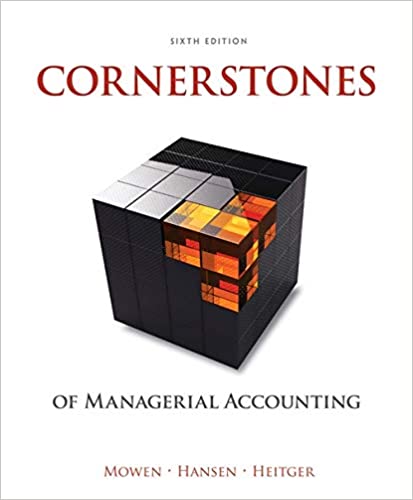
Cornerstones of Managerial Accounting 6th Edition by Maryanne Mowen,Don Hansen ,Dan Heitger
Edition 6ISBN: 978-1305103962
Cornerstones of Managerial Accounting 6th Edition by Maryanne Mowen,Don Hansen ,Dan Heitger
Edition 6ISBN: 978-1305103962 Exercise 32
(Appendix 3A) Method of Least Squares
Refer to the information for Farnsworth Company (p. 109) for the first 10 months of data on receiving orders and receiving cost. Now suppose that Tracy has gathered two more months of data:

Note: For the following requirements, round the intercept terms to the nearest dollar, round the variable rates to the nearest cent, and R-squared to two decimal places.
Required:
1. Run two regressions using a computer spreadsheet program such as Excel. First, use the method of least squares on the first 10 months of data. Then, use the method of least squares on all 12 months of data. Write down the results for the intercept, slope, and R 2 for each regression. Compare the results.
2. CONCEPTUAL CONNECTION Prepare a scattergraph using all 12 months of data. Do any points appear to be outliers? Suppose Tracy has learned that the factory suffered severe storm damage during Month 11 that required extensive repairs to the receiving area-including major repairs on a forklift. These expenses, included in Month 11 receiving costs, are not expected to recur. What step might Tracy, using her judgment, take to amend the results from the method of least squares?
3. CONCEPTUAL CONNECTION Rerun the method of least squares, using all the data except for Month 11. (You should now have 11 months of data.) Prepare a cost formula for receiving based on these results, and calculate the predicted receiving cost for a month with 1,450 receiving orders. Discuss the results from this regression versus those from the regression for 12 months of data.
Refer to the information for Farnsworth Company (p. 109) for the first 10 months of data on receiving orders and receiving cost. Now suppose that Tracy has gathered two more months of data:

Note: For the following requirements, round the intercept terms to the nearest dollar, round the variable rates to the nearest cent, and R-squared to two decimal places.
Required:
1. Run two regressions using a computer spreadsheet program such as Excel. First, use the method of least squares on the first 10 months of data. Then, use the method of least squares on all 12 months of data. Write down the results for the intercept, slope, and R 2 for each regression. Compare the results.
2. CONCEPTUAL CONNECTION Prepare a scattergraph using all 12 months of data. Do any points appear to be outliers? Suppose Tracy has learned that the factory suffered severe storm damage during Month 11 that required extensive repairs to the receiving area-including major repairs on a forklift. These expenses, included in Month 11 receiving costs, are not expected to recur. What step might Tracy, using her judgment, take to amend the results from the method of least squares?
3. CONCEPTUAL CONNECTION Rerun the method of least squares, using all the data except for Month 11. (You should now have 11 months of data.) Prepare a cost formula for receiving based on these results, and calculate the predicted receiving cost for a month with 1,450 receiving orders. Discuss the results from this regression versus those from the regression for 12 months of data.
Explanation
1. The regressions results are determine...
Cornerstones of Managerial Accounting 6th Edition by Maryanne Mowen,Don Hansen ,Dan Heitger
Why don’t you like this exercise?
Other Minimum 8 character and maximum 255 character
Character 255


